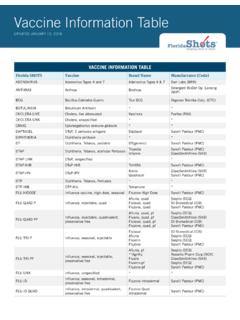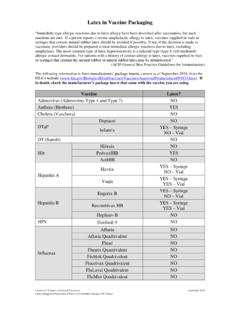Transcription of HIGHLIGHTS OF PRESCRIBING INFORMATION
1 HIGHLIGHTS OF PRESCRIBING INFORMATION ------------------------------------CONT RAINDICATIONS--------------------------- ----------- These HIGHLIGHTS do not include all the INFORMATION needed to use fluad safely and Severe allergic reaction to any component of the vaccine, including egg protein, or after a effectively. See full PRESCRIBING INFORMATION for fluad . previous dose of any influenza vaccine. (4, 11). fluad (Influenza Vaccine, Adjuvanted) ------------------------------WARNINGS AND PRECAUTIONS----------------------------- --- Suspension for Intramuscular Injection If Guillain-Barr Syndrome (GBS) has occurred within six weeks of previous influenza 2018-2019 Season vaccination, the decision to give fluad should be based on careful consideration of Initial Approval: 2015 the potential benefits and risks. ( ). ------------------------------------ADVE RSE REACTIONS------------------------------- -------- ------------------------------------INDI CATIONS AND USAGE--------------------------------- fluad is an inactivated influenza vaccine indicated for active immunization against The most common ( 10%) local (injection site) adverse reactions observed in clinical studies were injection site pain (25%) and tenderness (21%).
2 (6). influenza disease caused by influenza virus subtypes A and type B contained in the vaccine. fluad is approved for use in persons 65 years of age and older. (1) The most common ( 10%) systemic adverse reactions observed in clinical studies Approval is based on the immune response elicited by fluad . Data demonstrating a were myalgia (15%), headache (13%) and fatigue (13%). (6). decrease in influenza disease after vaccination with fluad are not available. (14). ------------------------------DOSAGE AND ADMINISTRATION-------------------------- ----- To report SUSPECTED ADVERSE REACTIONS, contact Seqirus at 1- 855-358-8966. A single mL dose for intramuscular injection. ( ) or VAERS at 1-800-822-7967 and -----------------------------DOSAGE FORMS AND STRENGTHS------------------------------ See 17 for PATIENT COUNSELING INFORMATION . Suspension for injection supplied in mL single-dose pre-filled syringes.
3 (3). FULL PRESCRIBING INFORMATION : CONTENTS 8. USE IN SPECIFIC POPULATIONS. 1. INDICATIONS AND USAGE Pregnancy 2. DOSAGE AND ADMINISTRATION Pediatric Use Dosage and Schedule Geriatric Use Administration 11. DESCRIPTION. 3. DOSAGE FORMS AND STRENGTHS 12. CLINICAL PHARMACOLOGY. 4. CONTRAINDICATIONS Mechanism of Action 5. WARNINGS AND PRECAUTIONS 13. NONCLINICAL TOXICOLOGY. Guillain-Barr Syndrome Carcinogenesis, Mutagenesis, Impairment of Fertility Preventing and Managing Allergic Reactions 14. CLINICAL STUDIES. Altered Immunocompetence 15. REFERENCES. Syncope 16. HOW SUPPLIED/STORAGE AND HANDLING. Limitations of Vaccine Effectiveness 17. PATIENT COUNSELING INFORMATION . 6. ADVERSE REACTIONS. Clinical Trials Experience Postmarketing Experience 7. DRUG INTERACTIONS *Sections or subsections omitted from the full PRESCRIBING INFORMATION are not listed. Concomitant Use With Other Vaccines Concurrent Use With Immunosuppressive Therapies FULL PRESCRIBING INFORMATION Table 1: Percentages of Subjects 65 Years of Age With Solicited Local 1.
4 INDICATIONS AND USAGE and Systemic Adverse Reactions in Days 1-7 After Administration fluad is an inactivated influenza vaccine indicated for active immunization against of fluad or AGRIFLU (a Licensed Comparator) NCT01162122. influenza disease caused by influenza virus subtypes A and type B contained in the Study 1. vaccine. fluad is approved for use in persons 65 years of age and older. Approval is fluad AGRIFLU. based on the immune response elicited by fluad . Data demonstrating a decrease in influenza disease after vaccination with fluad are not available. [see Clinical Studies (Na=3418-3496) (Na=3420-3488). (14)] Percentage Percentage 2. DOSAGE AND ADMINISTRATION. For intramuscular injection only Local Dosage and Schedule Any Injection Administer fluad as a single mL intramuscular injection in adults 65 years of age Moderateb site Pain and older. Severec Administration Any Gently shake each syringe.
5 fluad has a milky white appearance. Parenteral drug Tenderness Moderate products should be inspected visually for particulate matter and discoloration prior Severe to administration whenever solution and container permit [see Description (11)]. Any If either condition exists, fluad should not be administered. 25 to < 50 mm Erythema The vaccine should be administered by intramuscular injection, preferably in the 51 to < 100 mm < region of the deltoid muscle of the upper arm. Do not inject the vaccine in the gluteal > 100 mm region or areas where there may be a major nerve trunk. Any 3. DOSAGE FORMS AND STRENGTHS 25 to < 50 mm Induration fluad is a sterile suspension for intramuscular injection supplied in mL single-dose 51 to < 100 mm pre-filled syringes. > 100 mm 4. CONTRAINDICATIONS Any Do not administer fluad to anyone with a history of severe allergic reaction ( 25 to < 50 mm anaphylaxis) to any component of the vaccine, including egg protein [see Description Swelling 51 to < 100 mm < (11)], or to a previous influenza vaccine.
6 > 100 mm < 5. WARNINGS AND PRECAUTIONS Systemic Guillain-Barr Syndrome Any If Guillain-Barr syndrome (GBS) has occurred within 6 weeks of receipt of prior influenza vaccine, the decision to give fluad should be based on careful consideration of the Myalgia Moderate potential benefits and risks. The 1976 swine influenza vaccine was associated with Severe an elevated risk of GBS. Evidence for a causal relationship of GBS with other influenza Any vaccines is inconclusive; if an excess risk exists, it is probably slightly more than 1 Moderate Fatigue additional case per 1 million persons vaccinated. [see References (1)] Severe Preventing and Managing Allergic Reactions PLTd < Appropriate medical treatment and supervision must be available to manage possible Any anaphylactic reactions following administration of the vaccine. Moderate Headache Altered Immunocompetence Severe The immune response to fluad in immunocompromised persons, including individuals PLT < receiving immunosuppressive therapy, may be lower than in immunocompetent Any individuals.
7 [see Concurrent Use With Immunosuppressive Therapies ( )] Arthralgia Moderate Syncope Severe Syncope (fainting) may occur in association with administration of injectable vaccines Any including fluad . Ensure procedures are in place to avoid injury from falling associated Moderate with syncope. Chills Severe Limitations of Vaccine Effectiveness PLT < Vaccination with fluad may not protect all vaccine recipients against influenza disease. Any 6. ADVERSE REACTIONS Moderate Diarrhea Clinical Trials Experience Severe Because clinical trials are conducted under widely varying conditions, the adverse PLT < < reaction rates observed in the clinical trials of a vaccine cannot be directly compared to Any rates in the clinical trials of another vaccine and may not reflect rates observed in clinical C to C practice. Fever C to C Solicited adverse reactions were assessed in a multicenter, observer-blind, randomized C to C controlled study (Study 1) conducted in the United States, Colombia, Panama and the C Philippines.
8 The safety analysis set included 3545 fluad recipients and 3537 AGRIFLU. Any (Influenza Vaccine) recipients. The enrolled subject population in Study 1 was 65 to 97. years of age (mean 72 years) and 64% were female. Within each treatment group, 53% Moderate Nausea were Asian, 28% were Caucasian, 18% were Hispanic, 1% were Black, and fewer than Severe 1% each were Native American/Alaskan, Pacific Islander/Hawaiian, or Other. PLT < Solicited local (injection site) and systemic adverse reactions were collected from subjects Any in Study 1 who completed a symptom diary card for seven days following vaccination. Moderate Vomiting The reported frequencies of solicited local and systemic adverse events from Study 1 are Severe < presented in Table 1. PLT < a N = number of subjects with safety data. b Moderate: pain, tenderness, myalgia, fatigue, headache, arthralgia, chills, nausea, vomiting defined as some limitation in normal daily activity , diarrhea defined as 4 to 5 stools a day.
9 C Severe: pain, tenderness, myalgia, fatigue, headache, arthralgia, chills, nausea, vomiting defined as unable to perform normal daily activity , diarrhea defined as 6 or more watery stools a day . d Potentially life threatening (PLT) reaction defined as requiring emergency room visit or hospitalization. Unsolicited Adverse Events (AEs): The clinical safety of fluad was assessed in fifteen 8. USE IN SPECIFIC POPULATIONS. (15) randomized, controlled studies. The total safety population in these trials included Pregnancy 10,952 adults 65 years of age and older, comprising 5,754 who received fluad and Pregnancy Category B: A reproductive and developmental toxicity study has been 5,198 who received other US licensed influenza vaccines. The percentage of subjects performed in rabbits with a dose level that was approximately 15 times the human dose with an unsolicited AE within 30 days following vaccination was similar between vaccine based on body weight.
10 The study revealed no evidence of impaired female fertility or groups ( fluad vs. active comparator). harm to the fetus due to fluad . There are, however, no adequate and well-controlled Serious Adverse Events (SAEs) and Deaths: In Study 1, in which subjects were followed studies in pregnant women. Because animal reproduction studies are not always for SAEs and deaths for one year following vaccination (N=3,545 fluad , N=3,537 predictive of human response, this vaccine should be used during pregnancy only if AGRIFLU), the percentages of subjects with an SAE were similar between vaccine groups clearly needed. (7% fluad vs. 7% AGRIFLU). Four SAEs (1 fluad and 3 AGRIFLU) were assessed as In a reproductive and developmental toxicity study, the effect of fluad on embryo- related to study vaccination over one year of observation and 2 of these occurred (1 fetal and post-natal development was evaluated in pregnant rabbits.)




